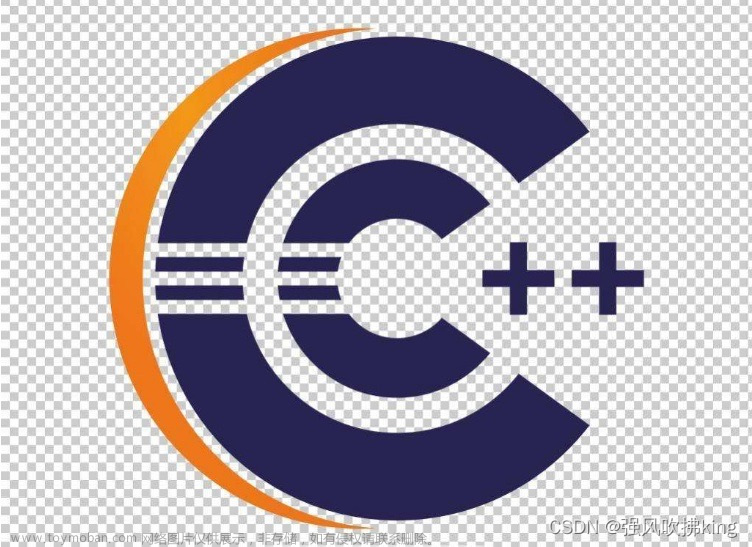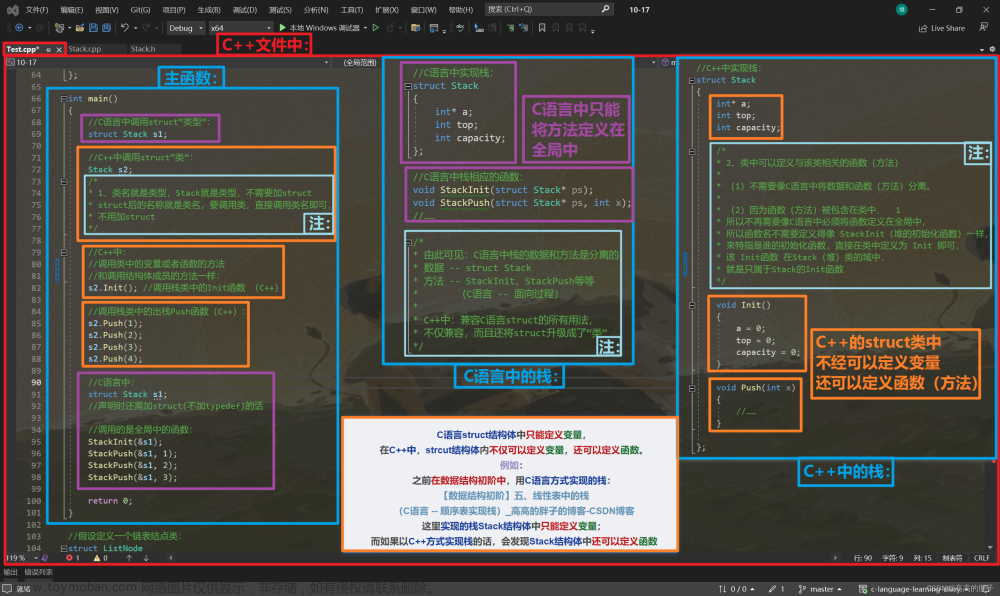C++面向对象的三大特征
- 封装
- 继承
- 多态
封装-类
- 具有相同性质的对象可以抽象为类,可以有属性,行为
- 类中的属性和行为统一称作成员
- 属性:成员变量,成员属性
- 行为:成员函数,成员方法
#include<iostream>
using namespace std;
const double PI = 3.14;
class Circle
{
public: // 访问权限
int r; // 属性
double cal_c() // 行为
{
return 2 * PI * r;
}
};
void main()
{
Circle c1; // 实例化一个对象, 通过类创建对象的过程
c1.r = 5;
double c = c1.cal_c();
cout << c << endl;
system("pause");
}
#include<iostream>
using namespace std;
class Student
{
public: // 访问权限
// 属性
string name;
int id;
// 行为
void show_name()
{
cout << name << endl;
}
void show_id()
{
cout << id << endl;
}
};
void main()
{
Student s1; // 实例化一个对象
s1.name = "Zhangsan";
s1.id = 20;
s1.show_name();
s1.show_id();
system("pause");
}
封装-访问权限
- public
–成员在类内可以访问,在内外也可以访问 - protected
–成员在类内可以访问,在内外不可以访问,子类可以访问 - private
–成员在类内可以访问,在内外不可以访问,子类不可以访问
code:
#include<iostream>
using namespace std;
class Person
{
public: // 访问权限
string name; // 属性
protected:
string car;
private:
int password;
public:
void set_info(string ref_name, string ref_car, int ref_password)
{
// 几种权限内类都可以访问
name = ref_name;
car = ref_car;
password = ref_password;
}
void show_info()
{
cout << name << "_" << car << "_" << password << endl;
}
};
void main()
{
Person p1;
p1.set_info("Lili", "BMW", 666888);
p1.show_info();
p1.name = "HanMeimei";
//p1.car = "BENZ"; // protected权限类外不能访问
//p1.password = 333; // private权限类外不能访问
p1.show_info();
p1.set_info("GuTianle", "Volvo", 123456); // 可以通过public的成员方法改变protected和private权限的成员变量
p1.show_info();
system("pause");
}
result:
Lili_BMW_666888
HanMeimei_BMW_666888
GuTianle_Volvo_123456
封装-struct和class的区别
- struct和class的默认访问权限不同。
– struct默认访问权限是public。
– class默认访问权限是private。
#include<iostream>
using namespace std;
class Person_c
{
string name; // 默认访问权限是private
void show_info()
{
cout << name << endl;
}
};
struct Person_s
{
string name; // 默认访问权限是public
void show_info()
{
cout << name << endl;
}
};
void main()
{
Person_c pc1;
// 类的默认访问权限是private,所以成员变量和函数在类外不能访问
// pc1.name = "LiuDehua";
// pc1.show_info();
// struct的默认访问权限是public,所以成员变量和函数在类外可以访问
Person_s ps1;
ps1.name = "Libai";
ps1.show_info();
system("pause");
}
封装-成员属性私有化
- 成员属性设置为私有,可以控制其读写权限
- 对于写权限,可以检测数据有效性
#include<iostream>
using namespace std;
class Person
{
private:
string name; // 默认访问权限是private
int age = 0;
public:
void set_info(string ref_name, int ref_age)
{
name = ref_name;
if (ref_age < 0 || ref_age > 150)
{
cout << "这是个妖怪!" << endl;
return;
}
age = ref_age;
}
void show_info()
{
cout << name << "_" << age << endl;
}
};
void main()
{
Person p1;
p1.set_info("Libai", 180);
p1.show_info();
system("pause");
}
封装-成员变量为类
#include<iostream>
using namespace std;
class Point
{
private:
int pos_x;
int pos_y;
public:
void set_info(int ref_x, int ref_y)
{
pos_x = ref_x;
pos_y = ref_y;
}
void get_info(int &x, int& y)
{
x = pos_x;
y = pos_y;
}
};
class Circle
{
private:
Point center;
int radius;
public:
void set_info(Point ref_center, int ref_radius)
{
center = ref_center;
radius = ref_radius;
}
void get_info(int& ret_center_x, int& ret_center_y, int& ret_radius)
{
center.get_info(ret_center_x, ret_center_y);
ret_radius = radius;
}
};
void is_incricle(Circle& c, Point& p)
{
int c_x, c_y, c_r;
c.get_info(c_x, c_y, c_r);
int p_x, p_y;
p.get_info(p_x, p_y);
int dis = (p_x - c_x) * (p_x - c_x) + (p_y - c_y) * (p_y - c_y);
if (dis > (c_r * c_r))
cout << "点在圆外" << endl;
else if (dis == (c_r * c_r))
cout << "点在圆上" << endl;
else
cout << "点在圆内" << endl;
}
void main()
{
Point p1;
p1.set_info(10, 9);
int p_x, p_y;
p1.get_info(p_x, p_y);
cout << "点的坐标是:" << "x=" << p_x << " y=" << p_y << endl;
Point p2;
p2.set_info(10, 0);
Circle c1;
c1.set_info(p2, 10);
int x, y, r;
c1.get_info(x, y, r);
cout << "圆的坐标是:" << "x=" << x << " y=" << y << " r=" << r << endl;
is_incricle(c1, p1);
system("pause");
}
封装-将类置于单独的文件中
poin.h文件
#pragma once
#include<iostream>
using namespace std;
// 在头文件中写上成员变量和成员函数的声明即可
class Point
{
private:
int pos_x;
int pos_y;
public:
void set_info(int ref_x, int ref_y);
void get_info(int& x, int& y);
};
poin.cpp文件
#include"point.h"
// 所有成员函数的实现放在源文件中,并说明函数的作用域
void Point::set_info(int ref_x, int ref_y)
{
pos_x = ref_x;
pos_y = ref_y;
}
void Point::get_info(int& x, int& y)
{
x = pos_x;
y = pos_y;
}
circle.h文件
#pragma once
#include<iostream>
using namespace std;
#include"point.h"
class Circle
{
private:
Point center;
int radius;
public:
void set_info(Point ref_center, int ref_radius);
void get_info(int& ret_center_x, int& ret_center_y, int& ret_radius);
};
circle.cpp文件
#include"circle.h"
void Circle::set_info(Point ref_center, int ref_radius)
{
center = ref_center;
radius = ref_radius;
}
void Circle::get_info(int& ret_center_x, int& ret_center_y, int& ret_radius)
{
center.get_info(ret_center_x, ret_center_y);
ret_radius = radius;
}
文章来源地址https://www.toymoban.com/news/detail-661138.html
文章来源:https://www.toymoban.com/news/detail-661138.html
到了这里,关于C++系列-类和对象-封装的文章就介绍完了。如果您还想了解更多内容,请在右上角搜索TOY模板网以前的文章或继续浏览下面的相关文章,希望大家以后多多支持TOY模板网!














